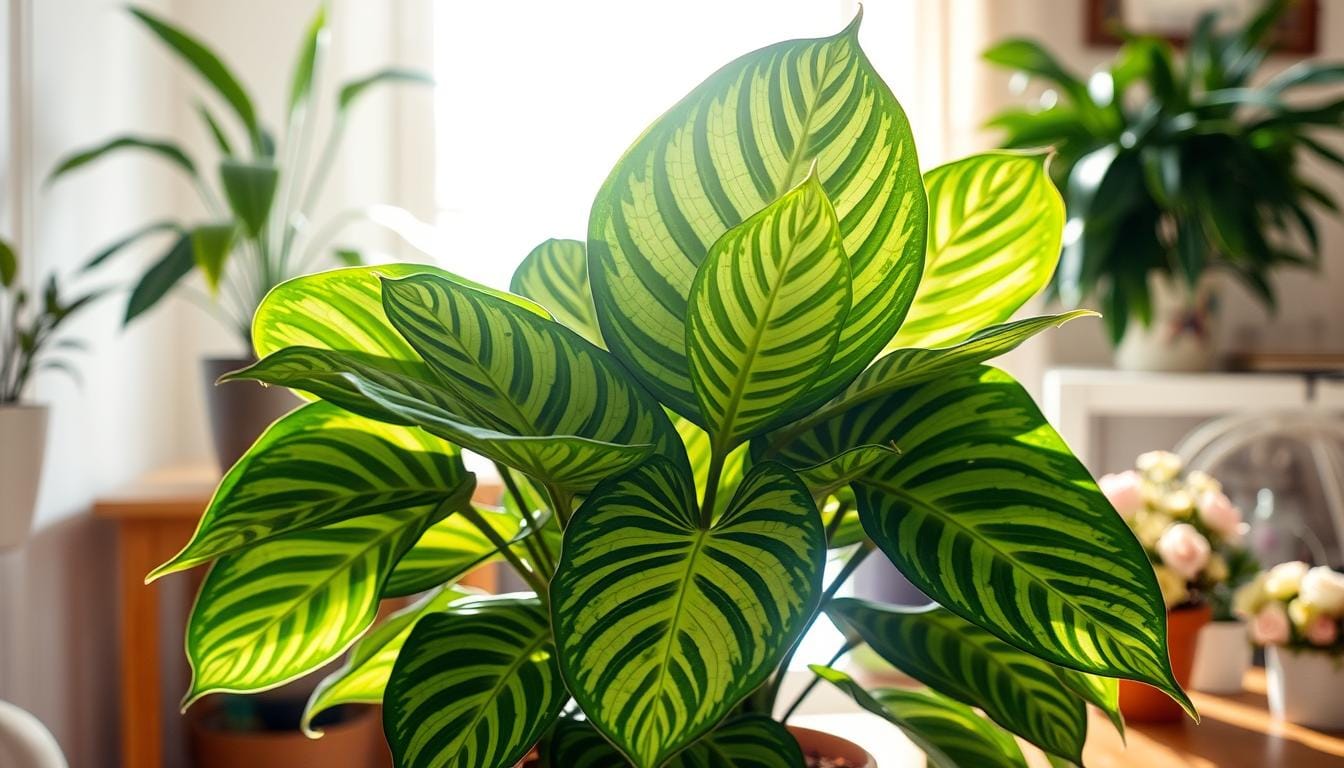The Mother in Law Plant, also known as the Sansevieria or Snake Plant, adds beauty to any room. It’s a favorite in homes across the United States. This plant is not only easy to care for but also cleans the air, making it a smart choice for improving indoor air quality.
This plant has unique, sword-shaped leaves and comes in many varieties. It’s perfect for both experienced and new plant lovers. This guide will help you grow and care for your own Sansevieria at home.
Key Takeaways
- The Mother in Law Plant, also known as the Sansevieria or Snake Plant, is a popular low-maintenance indoor plant.
- It boasts air-purifying qualities and is highly drought-tolerant, making it an excellent choice for busy homeowners.
- The plant features a diverse range of cultivars with distinct leaf shapes and color variations.
- Proper care, including optimal lighting, watering, and soil conditions, is essential for the plant’s health and growth.
- Propagation techniques, such as division and leaf cuttings, allow you to easily multiply your Sansevieria collection.
Understanding the Mother in Law Plant: Species and Origins
The mother-in-law’s tongue, also known as the sansevieria or snake plant, is a favorite among houseplants. It comes from the tropical areas of Africa and Asia. These plants have been around for centuries, adding a modern look to homes with their unique shapes.
Native Habitat and Natural Growth Patterns
In the wild, these plants love dry, well-drained spots like deserts and rocky areas. They grow thick leaves and strong roots to hold water. This helps them survive when it’s dry.
Different Varieties of Sansevieria
The sansevieria family has many species, each with its own look:
- The classic Sansevieria trifasciata, or snake plant, has stiff, sword-shaped leaves with bands.
- The cylindrical sansevieria types, like Sansevieria cylindrica, have tall, thin leaves that look like sculptures.
- Other favorites include the small Sansevieria parva, the colorful Sansevieria trifasciata ‘Laurentii’, and the small Sansevieria ‘Moonshine’.
Physical Characteristics and Growth Habits
Sansevieria plants stand out with their upright shapes and thick leaves. They can grow up to 3 feet tall, with leaves from a few inches to over a foot long. Some grow in clumps, while others have long stems.
“The sansevieria is a testament to nature’s resilience, thriving in the most challenging environments and bringing a touch of the exotic to any indoor space.”
Benefits of Growing Snake Plants Indoors
The snake plant, also known as the Mother-in-Law’s Tongue, is a great indoor plant. It has many benefits. These air purifying plants not only grow well in your home but also make it healthier.
One big plus of snake plants is how well they clean the air. These low maintenance houseplants remove harmful toxins like formaldehyde and benzene. They are a great addition to any indoor space.
Snake plants also produce oxygen at night, which is unique. This makes them perfect for bedrooms. They help improve air quality and promote better sleep.
Snake plants are also known for being easy to care for. These hardy plants can grow in many conditions. They are great for busy people or those new to plant care. Their striking leaves also add beauty to any room.

In conclusion, snake plants offer many benefits indoors. They purify the air, are easy to care for, and look great. These versatile plants are a smart choice for anyone wanting to improve their indoor space and enjoy the benefits of houseplants.
Ideal Growing Conditions for Mother in Law Plant
The mother in law plant, also known as the snake plant or sansevieria, is easy to care for. It’s a succulent and drought-tolerant plant. It doesn’t need much when it comes to light, temperature, and soil.
Light Requirements
The mother in law plant can grow well in different light conditions. It does great in low-light spots, like dim corners and offices. But, it looks best in bright, indirect sunlight. Direct sunlight can burn its leaves.
Temperature and Humidity Preferences
This plant is very hardy and can handle a wide range of temperatures. It can grow from 50°F (10°C) to 90°F (32°C). It’s perfect for indoor spaces because it can handle typical household humidity levels.
Best Soil Composition
The mother in law plant loves well-draining, slightly sandy soil. A mix made for succulents or cacti is great. It drains well and has the right nutrients. Stay away from heavy, clay-based soils to avoid root rot.
| Lighting | Temperature | Humidity | Soil |
|---|---|---|---|
| Bright, indirect sunlight | 50°F – 90°F (10°C – 32°C) | Typical household humidity | Well-draining, slightly sandy |
The mother in law plant is perfect for both new and experienced plant lovers. It’s easy to care for and can thrive in many environments. It’s a great choice for any home or office.

Watering Requirements and Schedule
Getting the watering schedule right for the succulent, drought-tolerant, and low-maintenance Mother in Law plant is key. These plants do well with a little neglect and can handle drought easily.
Water your Mother in Law plant sparingly. Water when the soil is dry to the touch. This means watering every 2-3 weeks in spring and summer. In winter, you can water once a month.
Don’t overwater your plant. Overwatering can cause yellow leaves, soft leaves, and rot. Underwatering makes leaves wrinkled and dry.
| Season | Watering Frequency |
|---|---|
| Spring and Summer | Every 2-3 weeks |
| Winter | Once a month |
The size of the pot and your home’s environment affect watering needs. Always check the soil before watering. Adjust your routine to keep your succulent healthy and thriving.

“Proper watering is the key to keeping your Mother in Law plant happy and healthy.”
Propagation Methods and Techniques
Propagating your indoor snake plant, also known as a sansevieria, is a great way to grow your collection. It’s perfect for both seasoned plant parents and beginners. Learning the different ways to propagate can help you multiply your snake plants successfully.
Division Method
One easy way to propagate a snake plant is through division. This method involves separating the plant’s rhizomes, or underground stems, and potting them up as individual plants. Just remove the plant from its pot, gently separate the rhizomes, and repot the divisions in their own containers with well-draining soil.
Leaf Cutting Propagation
Another effective method is leaf cutting propagation. Choose a healthy, mature leaf and cut it into segments. Make sure each piece has at least one node where new growth can emerge. Place the leaf cuttings in a well-draining potting mix or water, and new plants will develop from the nodes.
Water Propagation Tips
For a simpler approach, you can propagate snake plants in water. Just snip off a leaf, place the cut end in a container of water, and wait for roots to develop. Once the roots are several inches long, transplant the cutting into a pot with well-draining soil.

Regardless of the method you choose, be patient and provide the right growing conditions. Soon, you’ll have a thriving collection of these low-maintenance houseplants.
Common Pests and Diseases
Like any indoor plant or houseplant, the Snake Plant, also known as a Sansevieria, can face pests and diseases. But, with the right care and watchfulness, your indoor sansevieria can stay healthy.
Mealybugs are a common problem for indoor plants like the Snake Plant. These small, white, cotton-like pests feed on sap, causing leaves to turn yellow and wilt. Regular checks and treatments with insecticidal soap or neem oil can control mealybugs.
- Spider mites are another pest that can harm houseplants. These tiny, web-spinning arachnids love dry conditions and can spread fast, causing leaves to discolor and grow poorly.
- Root rot is a fungal disease that can affect sansevieria plants, especially if they get too much water. Signs include wilting, yellow leaves, and a bad smell from the soil.
To keep your indoor Snake Plant healthy, prevent pests and diseases. Make sure to water right, give it enough sunlight, and check it often for any signs of trouble. With some care, your sansevieria can live for many years.
| Pest/Disease | Symptoms | Treatment |
|---|---|---|
| Mealybugs | White, cotton-like pests; yellowing, wilting leaves | Insecticidal soap, neem oil |
| Spider Mites | Tiny webs; discoloration, stunted growth | Increase humidity, use insecticidal soap |
| Root Rot | Wilting, yellowing leaves; foul odor from soil | Improve drainage, reduce watering |

“Proper care and vigilance are key to keeping your indoor Snake Plant, or Sansevieria, healthy and thriving.”
Pruning and Maintenance Tips
Keeping your snake plant, or Mother in Law’s Tongue, healthy is easy. Just follow a few simple steps for pruning and cleaning. This will keep your low-maintenance houseplant looking great.
When and How to Prune
Prune your snake plant once or twice a year. Do this in the spring or early summer when it’s growing. Use clean, sharp scissors or pruning shears to cut off damaged or long leaves.
Make sure to cut just above a healthy leaf node. This helps the plant grow new leaves.
Cleaning and Maintenance Schedule
- Wipe down the leaves of your snake plant every few months. Use a damp cloth to remove dust and keep the leaves bright.
- Check the soil regularly. Water only when the top inch or two of soil is dry. Snake plants don’t like too much water.
- Fertilize your plant every few months during the growing season. Use a balanced, water-soluble fertilizer diluted to half strength.
- Watch for pests or disease. Deal with them quickly to keep your indoor plant healthy.
By following these easy tips, your snake plant will thrive. It will bring natural beauty to your home for many years.
Repotting Your Snake Plant
As your sansevieria, or snake plant, grows, it will need a bigger home. This is to fit its growing roots and keep it healthy. Knowing when to repot is important for a smooth process.
Watch for signs like roots circling the pot or soil drying fast. When it’s time, pick a pot just a bit bigger. Carefully move the plant to the new pot without harming the roots. Fill the new space with a good indoor plant soil, keeping the plant’s base level the same.
Repotting every two to three years keeps your snake plant thriving. It will keep your home air clean and add beauty. With some care, your Sansevieria will bring striking foliage and easy care for many years.





